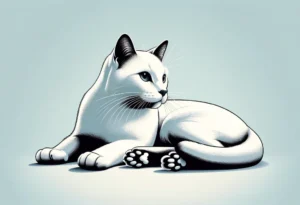Cats in Asia have short tails for a variety of reasons, ranging from genetics to practicality. Let’s explore the fascinating reasons behind this unique trait.
Cats in Asia have short tails due to a combination of genetic mutations, environmental factors, and cultural preferences. Understanding the origins of this characteristic sheds light on the diverse world of feline adaptations.
Genetic Mutations and Evolution
Short tails in Asian cats can be attributed to genetic mutations that have occurred over generations. These mutations have played a crucial role in shaping the physical characteristics of these cats, particularly in the Asian region. Natural selection has favored cats with shorter tails in certain environments, leading to the prevalence of this trait in Asian feline populations.
One interesting aspect to consider is the role of evolution in this process. Through adaptations to their surroundings, cats with shorter tails may have had a survival advantage, allowing them to navigate more efficiently in dense forests or urban environments. This advantageous trait has been passed down through genetic inheritance, contributing to the prevalence of short-tailed cats in Asia.
Environmental Adaptations
The environment in Asia has played a significant role in shaping the physical characteristics of cats in the region, including their distinctive short tails. In certain landscapes or climates, having a shorter tail can offer specific advantages to these felines.
For example, in dense jungles or urban areas with narrow alleyways, a shorter tail can enable cats to move more agilely and navigate through tight spaces with greater ease. This adaptation to their surroundings has become embedded in the genetic makeup of Asian cats, allowing them to thrive in diverse environments.
Additionally , the climate in Asia, which ranges from tropical to temperate, may have also influenced the development of short tails in cats. Shorter tails can help regulate body temperature more effectively in hotter climates, providing a natural cooling mechanism for these felines.
In conclusion , the presence of short-tailed cats in Asia is a fascinating example of how genetic mutations and environmental adaptations have interacted to shape the evolution of these beloved feline companions. Through natural selection and survival advantages, Asian cats have developed unique traits that make them well-suited to their surroundings.
Cultural Significance
In Asia, cats with short tails are often highly valued due to cultural beliefs and traditions that view them as symbols of good luck and fortune. In Japanese folklore, the bobtail cat is revered for its ability to bring blessings and ward off evil spirits, leading to a preference for cats with naturally short tails. Similarly, in countries like Thailand and China, short-tailed cats are associated with prosperity and happiness, making them popular pets in these regions. This intersection of folklore and practicality has led to a strong cultural preference for cats with short tails in Asia.
Breeds with Short Tails
Several cat breeds in Asia are known for their distinctively short tails, including the Japanese Bobtail and the Manx. The Japanese Bobtail is characterized by its uniquely short and kinked tail, while the Manx is famous for its complete lack of a tail or a very short stub. These breeds have captured the hearts of many due to their striking appearance and charming personalities. Despite their tail length, these cats are known for their intelligence, playfulness, and loyalty, making them beloved companions in households across Asia.
- Japanese Bobtail: Known for its short, kinked tail and sociable nature.
- Manx: Recognized for its tailless or short, stubby tail and strong hunting instincts.
- Kurilian Bobtail: Features a pom-pom-like short tail and a sturdy build, popular in Russia and Japan.
For more information on cat breeds with short tails, you can explore the characteristics of these unique felines and find the perfect match for your lifestyle.
Health Implications
Having a short tail can be both a blessing and a challenge for cats in Asia. While some may see it as a unique and distinctive trait, there are also potential health implications to consider. Cats with short tails may be more vulnerable to injuries, as the tail serves as a balance and communication tool for them. Additionally, certain breeds with naturally short tails may have underlying spinal issues that can lead to discomfort or mobility issues. It’s crucial for cat owners in Asia to pay close attention to their feline friends’ tail health and behavior, as any changes could indicate underlying problems that need prompt veterinary care.
Beauty Standards
Beauty standards in Asia play a significant role in the preference for cats with short tails. In countries like Japan and China, where aesthetics hold paramount importance, cats with unique and striking physical features, such as short tails, are highly sought after. The breeding practices in Asia often prioritize specific physical traits, including tail length, to meet these beauty standards. This emphasis on aesthetics has led to the popularity of certain breeds like the Japanese Bobtail, known for its short, kinked tail that is considered a symbol of good luck in Japanese culture.
Key Insight: In some Asian cultures, cats with short tails are believed to bring good fortune and prosperity, further driving the preference for these unique feline companions.
Folklore and Legends
In Asian cultures, cats with short tails have often been surrounded by intriguing myths and legends that delve into the symbolic meanings behind these unique felines. In Japan, for example, the bobtail cat, known as “Maneki-Neko,” is believed to bring good luck and fortune to its owner. Similarly, in Thailand, the “Siamese” cats with short tails were revered as sacred animals in ancient temples. These tales reflect the cultural significance and superstitions associated with cats in Asia, adding to the mystique and allure of these enigmatic creatures.
Conservation Efforts
While the genetics behind short-tailed cats in Asia are fascinating, it is equally crucial to emphasize the importance of conservation efforts in protecting these unique feline populations. Organizations such as the World Wildlife Fund (WWF) and local wildlife conservation groups are actively working to preserve biodiversity and ensure the survival of threatened cat species with short tails in Asia. By raising awareness about these conservation efforts, we can contribute to safeguarding these beloved animals for future generations to admire and cherish.
Additional Unique Insight:
Here are some practical ways you can personally contribute to the conservation of cats with short tails in Asia: 1. Support Wildlife Conservation Organizations: Donate to reputable organizations dedicated to protecting endangered cat species in Asia. 2. Adopt, Don’t Shop: Consider adopting a rescued cat from a shelter instead of buying one, thus reducing the demand for breeding and helping to save cat populations in the wild. 3. Spread Awareness: Educate others about the importance of species conservation and the preservation of unique feline traits in Asian cats. Sharing knowledge can inspire positive change and support for conservation efforts.
Alex, a passionate animal lover, has experience in training and understanding animal behavior. As a proud pet parent to two dogs and three cats, he founded AnimalReport.net to share insights from animal experts and expand his knowledge of the animal kingdom.









